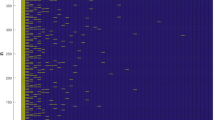Summary
The purpose of this paper is three-fold. The first purpose is to compile and to systematize published and dispersed results on two aspects of balancing in incomplete block designs, i.e., pairwise balance and variance balance. This was done in order to establish the status of these two concepts of balance in published literature and to put them in a form which is useful for further work in this area. Also, the results in this form are necessary for the development of the remainder of the paper.
The second purpose of this paper is to present a method of constructing unequal replicate and/or unequal block size experiment designs for which the variance balance property is achieved. The method of construction involves the union of blocks from two or more block designs and the augmentation of some of the blocks with additional treatments; the method is denoted asunionizing block designs. A straight-forward extension of the method would produce a partially balanced block design with unequal replicate and/or unequal block designs. The enlargement of the concept and availability of variance blanced block designs to accommodate unequal replication and/or unequal block sizes is important to the researcher, the teacher, and the experimenter needing such designs. For example, an animal nutritionist or a psychologist is no longer required to have constant litter or family sizes for the blocks and may have unequal replication on the treatments for those treatments with insufficient material and still attain the goal of equal variances on all normalized treatment contracts.
The third purpose of the paper is to apply the unionizing block designs method to construct a family of unequal replicate and unequal block size variance balanced designs. Some comments are given on the extension of the unionizing block designs method to construct other families of variance balanced or partially balanced block designs.
Similar content being viewed by others
References
Adhikary, B. (1965a). On the properties and construction of balanced block designs with variable replications,Calcutta Statist. Assoc. Bull.,14, 36–64.
Adhikary, B. (1965b). A difference theorem for the construction of balanced block designs with variable replications,Calcutta Statist. Assoc. Bull.,14, 167–170.
Agrawal, H. (1963). On balanced block designs with two different numbers of replications,J. Indian Statist. Assoc.,1, 145–151.
Agrawal, H. and Raghavachari, R. (1964). On balanced block designs with three different numbers of replications,Calcutta Statist. Assoc. Bull.,13, 80–86.
Atiqullah, M. (1961). On a property of balanced designs,Biometrika,48, 215–218.
Bose, R. C. and Shrikhande, S. S. (1960). On the composition of balanced incomplete block designs,Canadian J. Math.,12, 177–188.
Calinski, T. (1971). On some desirable patterns in block designs (with discussion),Biometrics,27, 275–292.
Das, M. N. (1958). On reinforced incomplete block designs,J. Indian Soc. Agric. Statist.,10, 73–77.
Das, M. N. and Rao, S. V. S. P. (1968). On balancedn-ary designs,J. Indian Statist. Assoc.,6, 137–146.
Federer, W. T. (1961). Augmented designs with one-way elimination of heterogeneity,Biometrics,17, 447–473.
Hedayat, A. (1971). Some contributions to the theory of locally and globally connected designs, BU-392-M inthe Biometrics Unit Mimeo Series, Cornell University.
Hedayat, A. and Federer, W. T. (1971). A family of binary balanced incomplete block designs with two unequal block sizes and two unequal replicates,Ann. Math. Statist. 42 (abstract).
John, P. W. M. (1964). Balanced designs with unequal numbers of replicates,Ann. Math. Statist.,35, 897–899.
Murty, J. S. and Das, M. N. (1967). Balancedn-ary block designs and their uses,J. Indian Statist. Assoc. 5, 73–82.
Rao, M. B. (1966). A note on equi-replicate balanced designs withb=v, Calcutta Statist. Assoc. Bull.,15, 43–44.
Rao, S. V. S. P. and Das, M. N. (1969). Incomplete weighing designs through balanced ternary designs,J. Indian Soc. Agric. Statist.,21(2), 67–72.
Rao, V. R. (1958). A note on balanced designs,J. Indian Soc. Agric. Statist.,29, 290–294.
Thompson, W. A. (1956). A note on balanced incomplete block designs,Ann. Math. Statist.,27, 842–846.
Tocher, K. D. (1952). The design and analysis of block experiments (with discussion),J. Roy. Statist. Soc., Ser. B.14, 45–100.
Vartak, M. N. (1963). Disconnected balanced designs,J. Indian Statist. Assoc.,1, 104–107.
Author information
Authors and Affiliations
Additional information
This investigation was supported in part by PHS Research Grant No. R01-GM-05900 from General Medical Services.
About this article
Cite this article
Hedayat, A., Federer, W.T. Pairwise and variance balanced incomplete block designs. Ann Inst Stat Math 26, 331–338 (1974). https://doi.org/10.1007/BF02479828
Received:
Revised:
Issue Date:
DOI: https://doi.org/10.1007/BF02479828




